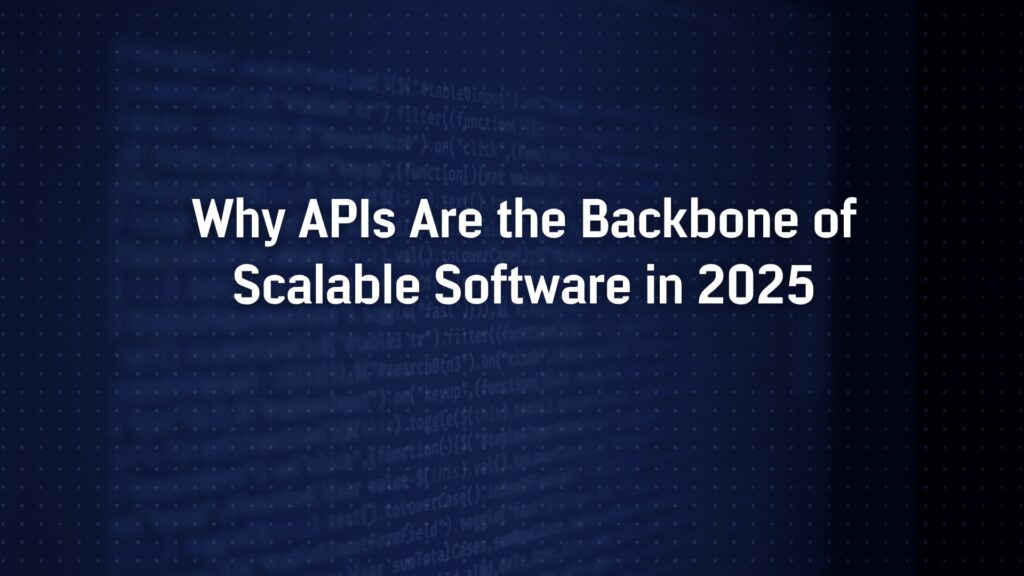Why APIs Are the Backbone of Scalable Software in 2025
What is an API?
APIs (Application Programming Interfaces) are the bridges connecting different software systems, enabling them to “talk” and exchange data seamlessly. In the modern API-first era, these interfaces are designed upfront as core components. This means that APIs become the foundation for application logic, not an afterthought. As one expert notes, APIs are “the backbone of communication between different software services”.
By 2025, treating APIs as first-class citizens will be crucial: it boosts agility, reuse, and integration. Leading architecture guides stress that an API-first approach improves scalability and flexibility by decoupling services. In short, designing software around APIs creates modular, maintainable systems that scale.
API-First Architecture: Designing for Scalability
Embedding API-first thinking means defining clear contracts and interfaces from day one. In practice, this involves using standards like OpenAPI/Swagger to specify endpoints, data models, and error handling before any code is written. Creating well-documented, consistent, reusable APIs is key.
Good API contracts include clear error-handling rules and robust versioning/ backward-compatibility policies.This upfront planning enables parallel teams to build services independently, accelerating development and reducing integration headaches. An API-first strategy aligns perfectly with microservices: applications break into small autonomous services, each exposing APIs . Those services can be developed, tested, and scaled in isolation.
Such architecture yields significant benefits. APIs allow independent deployment and scaling of each component. They facilitate automated load balancing and fault tolerance. As one analysis points out, API first systems become highly available and robust: “It facilitates load balancing, automated deployment, and fault-tolerant service design… [and] establishes a solid security perimeter”.
In practice, this means one service can be updated or scaled without downtime to others. In short, API-first design promotes scalability by letting each part of an application evolve on its own schedule, resulting in a system that can grow and adapt without a monolithic bottleneck .
How to Implement API-First Architecture:
-
- Design contracts first: Use tools like OpenAPI to define endpoints, data schemas, and error responses before coding.
-
- Auto-generate docs & code: Generate API docs, SDKs, and mocks from your API spec to streamline development (using tools like Swagger or Postman).
-
- Enforce standards: Apply consistent naming, authentication, and versioning policies via API governance. The API specification itself should include guidelines on error handling, version strategy, and backward compatibility .
-
- Build microservices: Organize functionality into small services exposing APIs. Each service can be developed and scaled independently.
-
- Use API gateways: Introduce an API Gateway as a single entry point to handle cross-cutting concerns (security, routing, rate limiting) for all services.
Seamless Integrations Across Platforms
APIs shine in connecting systems and services, enabling once complex integrations. Put simply, API integration is “the process of creating a coherent network of applications using APIs,” which yields a streamlined data flow between platforms.
This is why modern software (especially SaaS, fintech apps, and eCommerce sites) relies heavily on APIs to integrate with external services like payment gateways, data providers, and logistics partners. For example, an eCommerce platform may use payment APIs (Stripe, PayPal), shipping APIs (FedEx, UPS), and inventory/CRM APIs communicating via standardized REST or GraphQL interfaces.
In a microservices environment, integrations are typically managed through an API gateway, a central hub that “acts as a reverse proxy…between a client and microservices”. An API gateway encapsulates the system’s complexity. It accepts client requests, applies security checks and routing rules, and then forwards calls to the appropriate microservice. This ensures clients don’t need to know the details of every backend service.
As one guide notes, gateways “provide an API for each client…letting clients talk to it instead of calling specific services”. In practice, clients hit the gateway endpoint, and the gateway then invokes the needed microservices (for example, a single “shopping cart” API call might fetch data from separate inventory, pricing, and order services behind the scenes).
In a typical microservices setup, an API Gateway sits at the edge. It centralizes authentication/ routing and forwards client requests to individual services (e.g., Payment, Order, Catalog). By validating and securing requests here, the backend services can focus solely on business logic.
The key to integration is keeping APIs consistent and reusable. This promotes a uniform user experience across devices and simplifies connecting new services. For instance, one Moesif report highlights that API first designs ensure “APIs are consistent and reusable,” which “promotes system interoperability, simplifying the integration process with a vast array of apps and services”.
In practice, integrations should use standardized data formats (JSON, Protocol Buffers) and clear versioning. An organization can treat APIs as products, complete with documentation and developer portals, to make it easy for partners to consume them.
How to Integrate Systems via APIs:
-
- Centralized routing/security: Use an API gateway (or iPaaS) to orchestrate calls between services. This abstracts service endpoints from clients.
-
- Document APIs: Provide clear docs or SDKs so integrators know how to call your API. Well-written specs accelerate adoption and reduce errors.
-
- Implement orchestration: For multi-service workflows (e.g., checkout), create composite endpoints or workflows so clients need only one API call.
-
- Ensure versioning: Maintain backward compatibility so integrations don’t break when you update an API. Proper versioning is essential.
-
- Monitor and test: Continuously monitor API performance and use contract tests/mock servers to ensure integrations work as expected across changes.
By 2025, integration platforms will be even more vital. Industry experts predict 2025 will be a “critical year for the development of integration technologies” that meet demands for flexibility and scalability. In other words, as businesses grow, they will invest in smarter API orchestration (even AI-assisted) to keep everything connected efficiently.
API Security: Protecting the Core
As APIs become the nervous system of applications, security is paramount. In 2025, malicious actors will continue targeting APIs, so robust defenses are required. Common API risks (per OWASP) include broken authentication/authorization (e.g., BOLA: Broken Object Level Authorization), injection flaws, and insufficient logging.
OWASP lists “broken object-level authorization” as the #1 API security risk. This underscores the need for strict access controls and input validation on every API endpoint.
One foundational practice is to front your APIs with a gateway that enforces security policies. As Curity explains, “API gateways centralize traffic features…like rate limiting, blocking malicious clients, and proper logging.”
Without a gateway, each service would need to individually implement these protections, an error-prone approach. The gateway can handle cross-cutting concerns: enforcing HTTPS/TLS, authenticating requests (OAuth, JWT tokens), and throttling or blacklisting bad traffic. For example, incoming calls can be checked for valid OAuth tokens before any request ever reaches the backend service. This ensures that only authenticated, authorized requests are allowed.
Additional best practices include: using OAuth 2.0/OpenID Connect for authorization (issuing JWT or opaque tokens), validating all inputs to prevent injections, and applying the principle of least privilege (issuing tokens with minimal scopes). It’s also critical to log and monitor all API traffic for anomalies. Any management plane (dashboard, analytics) should be protected as rigorously as the APIs themselves.
Finally, zero-trust architectures are becoming standard for APIs: “Trust no one” by default. This means verifying every request, even internal ones, and denying all access unless explicitly allowed. In practice, services should verify JWT claims on each call and enforce fine-grained access controls (e.g., who can read or write each resource). These practices mitigate the top API threats and help ensure your API remains a secure, scalable system component.
Example: SaaS, FinTech, and eCommerce Use-Cases
APIs underpin many successful SaaS, fintech, and e-commerce platforms today. In SaaS (Software-as-a-Service), APIs allow modular functionality: for example, a CRM SaaS exposes APIs for contacts, leads, and invoices so that external tools and integrations (marketing apps, ERP systems) can interact with the core product.
In fintech, APIs connect to banking networks, payment processors, and fraud detection systems. For instance, a fintech app might use APIs to integrate with Plaid (bank data), Stripe (payments), and Blockchain services, all secured and abstracted via the app’s API layer.
In eCommerce, APIs link storefronts to inventory databases, review systems, and fulfillment services (like shipment tracking and warehouse management), enabling retailers to scale globally with multiple third-party integrations.
A famous example is Amazon’s 2008 “Death Star” microservices map. By splitting a monolithic site into dozens of API-backed services, Amazon achieved a highly scalable system. Each microservice could be developed, deployed, and scaled independently. This modular, API-driven design lets Amazon innovate faster and handle massive growth without disruptions.
Empyreal Infotech understands these industry needs. As a custom software agency, Empyreal emphasizes clean, scalable architectures and builds API-first solutions across domains. Their services explicitly include web/mobile development, e-commerce platforms, CRM apps, and SaaS software, indicating hands-on experience in e-commerce and SaaS.
They highlight projects in finance and retail (covering FinTech and eCommerce), delivering “discipline[d] architecture” and 24/7 support. In practice, this means Empyreal can create robust API integrations for a fintech startup (e.g., secure payment APIs) or an eCommerce store (e.g, connecting to shipping/payment partners) while ensuring each service scales. By leveraging best-practice API design and security, Empyreal helps SaaS, FinTech, and eCommerce clients grow without outgrowing their architecture.
Best Practices & How-To Tips
Adopt API Governance:
Establish an API style guide and require reviews. Consistent naming, versioning rules, and documentation standards reduce bugs and speed up onboarding for new developers. Automated linters/validators for OpenAPI specs can enforce these rules.
Design with Failure in Mind:
Use rate limiting, retries, and circuit breakers. Expect some API calls to fail under load; graceful degradation (e.g., caching responses, returning partial data) keeps apps resilient.
Implement CI/CD for APIs:
Automate building, testing, and deploying APIs. Include integration tests against staging servers so that changes in one service don’t break others. This ensures your scalable API ecosystem remains stable.
Monitor & Analyze:
Use API analytics to track usage patterns and performance. Metrics like error rates, latency, and throughput can alert you to bottlenecks. In 2025, using observability tools with AI-driven anomaly detection will be key.
Evolve APIs Gradually:
When extending an API (say, adding fields or endpoints), use versioning or feature flags. Communicate changes in advance to consumers and maintain old versions temporarily to avoid disruption. Reuse as much code and logic as possible to cut costs and time .
Practice Least Privilege & Defense in Depth:
In addition to gateway-level auth, have services perform their access checks. Use separate tokens for inter-service calls. Regularly audit your access logs. Remember that “no security is complete without defense in depth.”
By following these API-first, integration, and security best practices and learning from real-world leaders, companies can build truly scalable, resilient software in 2025. Well-designed APIs let businesses innovate quickly (adding new features or partners) without re-architecting their systems.
As industry trends show, APIs will only grow in strategic importance . With the right architecture and vigilance, APIs are indeed the backbone that will support the next generation of scalable software, and partners like Empyreal Infotech can help guide that journey.




